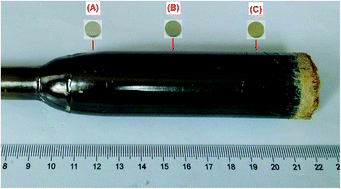Bridgman growth and electrical properties of Nd-doped PMN–PT single crystal with ultrahigh piezoelectricity
Abstract
Using the polycrystalline material with a nominal composition of Nd0.01Pb0.985[(Mg1/3Nb2/3)0.70Ti0.30]O3, an Nd-doped PMN–PT single crystal has been grown successfully by a vertical Bridgman process. The perovskite structure and the crystalline phase evolution of the as-grown crystal were confirmed by X-ray diffraction analysis. A series of (001)-oriented crystal wafers, fabricated from different regions of the as-grown crystal boule, were characterized systematically to verify their electrical properties. Compared to the undoped PMN–PT single crystal, the crystal wafers under direct current polarization exhibited an improved piezoelectric coefficient d33 of 1780–2870 pC N−1, along with a lower phase transition temperature T and a lower Curie temperature Tc in the range of 55–63 °C and 95–141 °C, respectively. The coercive field Ec and the remnant polarization Pr for the crystal wafers were measured to be 1.7–2.7 kV cm−1 and 23.9–32.7 μC cm−2, respectively. It was found that the piezoelectric coefficient d33 of the crystal wafer could be even elevated to the range 2200–3650 pC N−1 by applying alternating current polarization. The improved piezoelectricity for the crystal wafer under alternating current polarization may be associated with the increased domain density inside the crystal medium.



 Please wait while we load your content...
Please wait while we load your content...